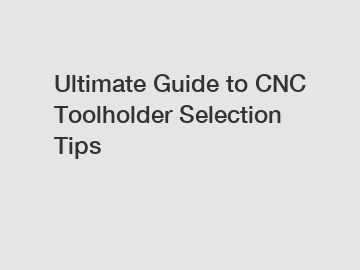Ultimate Guide to CNC Toolholder Selection Tips
When it comes to CNC machining, one of the most important decisions you'll make is selecting the right toolholder for your machine. The toolholder is what holds the cutting tool in place and transfers power to it, so choosing the correct one can have a significant impact on the quality of your workpiece and the efficiency of your machining process. In this ultimate guide, we'll walk you through some key tips for selecting the best toolholder for your CNC machine.
1. Understand the Different Types of Toolholders.
There are several different types of toolholders available for CNC machines, including collet chucks, end mill holders, and hydraulic chucks. Each type has its own advantages and disadvantages, so it's important to understand the differences between them before making a decision.

Collet chucks are highly versatile and easy to use, making them a popular choice for many CNC machinists. End mill holders are ideal for heavy-duty cutting applications, while hydraulic chucks provide excellent vibration damping for high-speed machining operations.
2. Consider the Material You're Machining.
The material you're machining will also play a significant role in determining the best toolholder for your needs. Different materials have different cutting characteristics, so it's important to choose a toolholder that is specifically designed for the material you're working with.
For example, if you're machining aluminum, a collet chuck may be the best option due to its versatility and ease of use. On the other hand, if you're working with hardened steel, a hydraulic chuck with excellent vibration damping properties may be more suitable.
3. Pay Attention to Toolholder Accuracy.
Toolholder accuracy is crucial for achieving precise and repeatable machining results. Poor toolholder accuracy can lead to tool runout, vibration, and poor surface finish on your workpiece. When selecting a toolholder, be sure to look for one that provides high levels of accuracy to ensure the quality of your machining operations.
4. Consider the Shank Size and Tool Holding Capacity.
The shank size of the toolholder should match the shank size of your cutting tool to ensure a secure and stable connection. Additionally, consider the tool holding capacity of the toolholder to ensure it can accommodate the size and weight of your cutting tool.
5. Evaluate the Balance and Runout of the Toolholder.
An unbalanced toolholder can lead to vibration and poor surface finish on your workpiece, while excessive runout can cause tool wear and reduced cutting performance. When selecting a toolholder, be sure to evaluate its balance and runout specifications to ensure optimal performance.
6. Choose a Reputable Manufacturer.
When selecting a toolholder for your CNC machine, it's important to choose a reputable manufacturer known for producing high-quality products. A reputable manufacturer will provide you with a toolholder that is reliable, durable, and backed by excellent customer support.
7. Consider Your Machining Environment.
The environment in which you'll be machining also plays a role in selecting the right toolholder. Factors such as temperature, humidity, and cleanliness can impact the performance of your toolholder, so be sure to choose one that is suitable for your specific machining environment.
8. Consult with Industry Experts.
If you're unsure about which toolholder is best for your CNC machine, don't hesitate to consult with industry experts for guidance. They can provide you with valuable advice and recommendations based on their experience and expertise.
In conclusion, selecting the right toolholder for your CNC machine is a critical decision that can impact the quality and efficiency of your machining operations. By understanding the different types of toolholders, considering the material you're machining, paying attention to toolholder accuracy, shank size, tool holding capacity, balance, runout, choosing a reputable manufacturer, considering your machining environment, and consulting with industry experts, you can make an informed decision that will help you achieve optimal results in your CNC machining projects.
If you want to learn more, please visit our website Er Collet System, Types of Tool Holder, Different Types of Vise.

